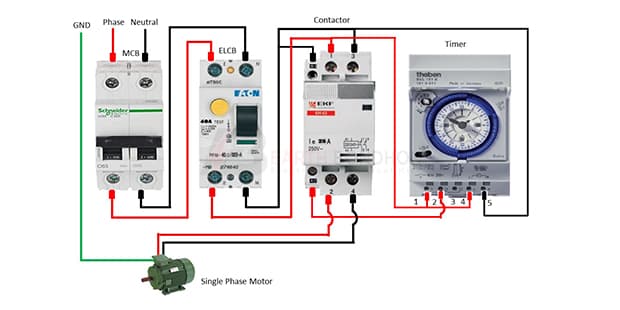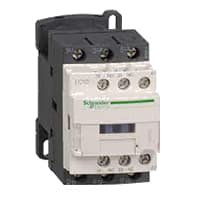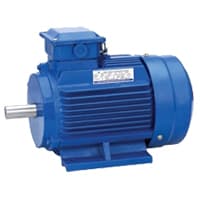Single Phase Motor Starter with Timer:
This diagram shows how to make a single-phase motor starter with a timer. In this circuit, we use a DP MCB ( Double Pole Miniature Circuit Breaker ), an ELCB ( Earth Leakage Circuit Breaker ), a magnetic contactor, a single-phase motor, and a timer. First, we need to input power to DP MCB, then from DP MCB to input power ELCB, then input power to contactor and timer from ELCB. And lastly input power to the motor. Now this circuit is ready for use. If you want to know more about this circuit please check our youtube video below the link.
Advertisements
Components needed For this Project:
You can get the components from any of the sites below:
- DP MCB 20A [See Buy Click Amazon]
- DP ELCB 16A [See Buy Click Amazon]
- Magnetic Contactor 25A [See Buy Click Amazon]
- 8 Pin Timer 220V AC [See Buy Click Amazon]
- Single Phase Motor (1 HP) [See Buy Click Amazon]
*Please note: These are affiliate links. I may make a commission if you buy the components through these links. I would appreciate your support in this way!
Advertisements
Components used to make the Single Phase Motor Starter with Timer:
DP MCB In 2 Pole MCB, switching & protection is affected in phases and the neutral. A Double Pole or DP Switch is a Switch that Controls 2 Circuits at the same time. In terms of Residential Switching, this Normally means it Switches the live and Neutral at the same time. In Layperson Terms, Double Pole switches or DP Switches are Exclusively Designed to Control 2 Different Electrical Circuits at the same time, which allows the Appliances to Isolate safely and reliably. Fan or light Combinations and Medical Equipment are some of the many applications for DP Electrical Switches and Electrical components.
02. ELCB:
ELCB complete earth leakage circuit breaker works on earth leakage production. Usually, the ELCB circuit breaker has two cables Phase and Neutral if any load is directly connected to the earth without taking neutral from ELCB then the circuit breaker will trip automatically. Earth leakage circuit breakers are used in applications to prevent electric shock and electrical fire caused by a short circuit or overload in the control panel by automatically closing when leakage is detected.
A magnetic contactor is an electromagnetic switching device. It is generally used for controlling 3-phase Motors. The operation of a magnetic contactor is similar to that of a Relay. but a relay is used for low-power or low-voltage connections, and a magnetic contactor is used for high-power or high-voltage connections. As soon as the supply is applied to the magnetic contactor coil. its normally open contacts are closed and normally closed contacts are opened and the associated devices are also operated. This is how a magnetic contactor works.
04. Timer:
A timer is a type of time-switching device that controls and controls Electrical circuits and electrical and electronic devices through time setting (on/off). The timer is basically 8-pin. Like other controlling devices the timer has a coil and when this coil is magnetized, the timer works on/off. The timer has 2 common ends and each common end has normally close and normally open options. When the timer is set by time, the timer trips at the end of that time and turns the common is normally closed (on) to open (off) and normally open (off) to close (on). This is how the timer works.
A Single-Phase Motor is an Electrically-Powered Rotary Machine That Can Turn Electric Energy into Mechanical Energy. It Works by Using a Single-Phase Power Supply. Single-phase Motors Are Used in Equipment And Machines That Are Smaller in Size And Require Lower Horsepower. This Includes Equipment Such As Refrigerators, Pumps, Compressors, Fans, and Portable Drills. Single-phase motors Have a Similar Construction to The 3-phase Motor, Including an AC Winding That is Placed on The Stator And Short-Circuited Conductors That are Placed in a Cylindrical Rotor.
Thank You for visiting the website. Keep visiting for more Updates.
Frequently asked questions
Without a capacitor, a single-phase motor cannot produce the necessary phase shift and will not start. When power is supplied to a single-phase motor, the current in the stator winding creates a magnetic field that oscillates back and forth, but it does not rotate.
We could easily conclude that the single-phase induction pumps are not self-starting because the produced stator flux is alternating in nature and at the starting, the 2 components of this flux cancel each other, or hence there is no net torque.
A run capacitor (figure 9) is used in single-phase pumps to maintain a running torque on an auxiliary coil while the motor is loaded. These capacitors are considered continuous duty while the motor is powered and they remain in the circuit diagram while the start capacitor drops out.
There are 4 common failure modes for single-phase AC motors. First, one of the windings could break, leading to an open circuit diagram. Second, the insulation could fail, leading to a short circuit diagram. Third, the motor could be overloaded for numerous reasons (which can also lead to the 1 failure).
If a single-phase motor is taking more current than normal, it could be indicative of several potential issues. Some common causes include: Overloading: If the motor is being asked to do more work than it is designed for, it may draw excessive current.
Read more Single Phase Wiring
What is a kilowatt-hour (kWh) | kwh formula | What does kwh mean
Introduction to Electrical Units and CircuitskW and kWh on your electricity bill As your home uses electricity during...
What is the Difference Between kVA | What does KVA mean | kVA formula
Difference Between KVA ExplainedWhat does KVA Mean? There are technical terms aplenty when it comes to generators, and...
Power Factor | Power Unit | Energy | Electricity Unit
Power factor definition | Calculating Power FactorPower Factor Values In a purely resistive circuit, the power factor...






0 Comments